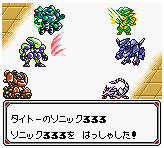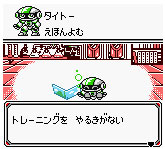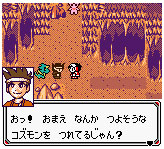|
|

|
PLATFORM
|
GBC
|
BATTLE SYSTEM
|

|
INTERACTION
|

|
ORIGINALITY
|

|
STORY
|

|
MUSIC & SOUND
|

|
VISUALS
|

|
CHALLENGE
|
Moderate
|
LANGUAGE BARRIER
|
Low
|
COMPLETION TIME
|
Less than 20 Hours
|
|
OVERALL

|
+ Long, variable evolutionary series
+ Comprehensive monster-training regimen
+ Three-on-three battles
- Lots of weird little design choices
- Definitely mimics a certain series...
- ...and yet is almost nothing like it
|
Click here for scoring definitions
|
|
|
When the world's most famous monster-collecting game busted into the market in 1996, it made a splash. Just how big a splash was pretty obvious by the end of the decade, and it seemed like every company in the industry was intent on capitalizing on the boom somehow. For Taito, that intent took the form of Monster Traveler.
This is a game with a pun in the heart of its title, as the colors used in the cover art make it clear that it could just as easily be rendered as "Mon-Star Traveler". This pun is thematically important because the game's setting is not of this earth. Instead, Monster Traveler takes place in a star system five light-years distant, on three separate worlds and a mysterious moon. Sand-Star is a world of dusty plains, wind farms, and rugged frontiersmen. Wood-Star is a beautifully forested sphere, full of life. Hydro-Star is mostly covered in water, except for a few tropical islands. Rough-Moon is apparently uninhabited, though no expedition has been able to safely land there and make sure.
The three planets and their errant satellite were once the home of an ancient civilization that reached its peak some two thousand years ago, but it disappeared under unexplained circumstances that never really become pertinent to the game itself. The only things left from that era are a series of crumbling ruins and the myriad varieties of monsters that are common to all three worlds. The connection between these monsters and the ancient civilization are again not well explained, but the main point of importance to the plot is that there is supposedly a device hidden away in a lost city that is capable of bestowing speech upon monsters. The hero's goal is to find that machine and be able to speak with his monstrous friends. Everything else, from hints of interstellar intrigue to the criminal syndicate known as the Dogma Darks, is strictly secondary.
 Time to face off.
Time to face off.
|
|
Monster Traveler is obviously supposed to resemble the world's most popular monster-collecting game. Its graphics are amazingly similar at times, as are its area layouts. The opening part of the game even includes the standard "choose your monster" section, with the possibilities being the saurian Maru, the mammalian Pito, or the robotic Maga. It's only when the player really starts into training that the differences become apparent, and Monster Traveler reveals itself as not quite what was advertised.
First, battles do not give experience, but they do give money. The player must pay for courses at the local training center, with prices increasing according to the monster's rank. Courses tend to target specific stats, raising one by several points, while at the same time possibly raising allied stats by a little, or lowering opposing stats by one or two points. Focusing exclusively on one trait will eventually result in single-digits for at least one other stat, so a healthy balance is required to ensure that the total gains outnumber the losses. Stat point balance is incredibly important in this game, as that is what determines the forms the player's monsters will achieve.
 Some books are just too hard.
Some books are just too hard.
|
|
This brings us to the second big difference. The three starting monsters are the base forms from which every other monster in the game develops — all one hundred forty-seven of them. By tweaking the stats in training, it's possibe to direct the trajectory of their growth and evolution, so that they can attain a desired form. There are seven ranks of monster between the starters and the boss-type S Rank, and while most evolutions will coincide with a jump in rank, it's possible to switch forms within a single rank as well. Each transformation brings a substantial stat boost as well as a new special attack to add to the list, so it's generally a good idea to experiment with point spreads in training.
The third big difference is that there is no monster-catching in this game at all. Instead, the player is presented with the same choice of starter monsters at three points in the game. It's possible to get the same starter three times straight, but then train them into vastly different forms with distinct movesets. Those three monsters are all the player will have until the post-game, however. This malleability of monster form is the game's biggest feature, and it's something of a shame that it wasn't pushed even farther. With one hundred fifty monsters spread across myriad subtypes, it certainly had a sound enough base to work off of.
Combat is actually a cut above what could be found in that other major popular monster-collecting franchise in 2001. Battles can have up to three monsters on a side, and the monster sprites are very well rendered. Everything has multiple poses and a decent amount of battle animation. The contrast between the battle graphics and the field graphics is both sharp and disappointing, because it only underscores just how lackluster most of the game is.
 If monsters are our friends, why are they always getting in the way?
If monsters are our friends, why are they always getting in the way?
|
|
Monster Traveler is littered with little oddities in its programming, most of which do not have any real justification. For example, why give the player the ability to run if it will only work in towns or (much more rarely) in the connecting areas between towns? Perhaps two-thirds of the game actually takes place in areas that do not allow running, including the interior of all buildings, and the towns themselves are so compact that the feature isn't necessary. Another thing is the wandering monsters, enemies whose sprites appear directly in the field, but which are gone forever once they're defeated. While they're a welcome gameplay element, they also raise the question of why the developers didn't just make all encounters respawning versions of this, instead of gracing the player with a highly variable random battle frequency. The next battle could take fifty steps to happen, or perhaps just two, with no way of telling which — and since it's possible to run away from one hundred percent of all random battles, it's not like they're really getting in the way of anything. This means it's also possible to bypass almost all obstacles to progress that aren't actually blocking the path on the field, and save up on healing items in the process. Since any purchase in stores takes away from the training fund, this is probably for the best.
Taito probably put a lot of thought and effort into this game, but it only shows up in the evolution system and the graphics. Everything else feels like a half-hearted attempt to cash in on the semblance of a better constructed and more popular franchise, even if the final product amounts to a bait-and-switch to any players who think they know what they're getting into. I'd like to say that Monster Traveler rose above it all and provided a great experience on the Game Boy Color, but... it didn't. It didn't even come close. Per insufficientiam ad astra.
Review Archives
|









